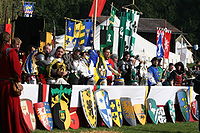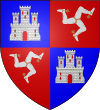Portal:Heraldry
Welcome to the Heraldry and Vexillology Portal!


Vexillology (from the Latin vexillum, a flag or banner) is the scholarly study of flags, including the creation and development of a body of knowledge about flags of all types, their forms and functions, and of scientific theories and principles based on that knowledge. Flags were originally used to assist military coordination on the battlefield, and have evolved into a general tool for signalling and identification, particularly identification of countries.
Heraldry encompasses all of the duties of a herald, including the science and art of designing, displaying, describing and recording coats of arms and badges, as well as the formal ceremonies and laws that regulate the use and inheritance of arms. The origins of heraldry lie in the medieval need to distinguish participants in battles or jousts, whose faces were hidden by steel helmets.
Selected coat of arms

The coat of arms of Munich (Münchner Wappen) depicts a young monk dressed in black holding a red book. It has existed in a similar form since the 13th century, though at certain points in its history it has not depicted the central figure of the monk at all. As the German name for Munich, i.e. München, means of Monks, the monk in this case is a self-explanatory symbol who represents the city of Munich. Appearing on a document of May 28, 1239, the oldest seal of Munich has a picture of a monk wearing an open hood. While all seal impressions show the monk with the book in one hand and three outstretched fingers in the other, the monk has varied slightly, appearing in profile, then later full-faced and bare-headed. By the 19th century the figure was portrayed as youthful and became known as the Münchner Kindl or Munich Child. The coat of arms in its current form was created in 1957 and is still an important symbol of the Bavarian state capital. (more...)
Selected flag

The Flag of Scotland, (Scottish Gaelic: Bratach nàiseanta na h-Alba, Scots: Banner o Scotland), also known as Saint Andrew's Cross or The Saltire, is the national flag of Scotland. Consisting of a blue background over which is placed a white representation of an X-shaped cross, the Saltire is one of Scotland's most recognisable symbols.
According to legend, the Christian apostle and martyr Saint Andrew, the patron saint of Scotland, was crucified on an X-shaped cross at Patras, (Patrae), in Achaea. Use of the familiar iconography of his martyrdom, showing the apostle bound to an X-shaped cross, first appears in the Kingdom of Scotland in 1180 during the reign of William I. Use of a simplified symbol associated with Saint Andrew which does not depict his image has its origins in the late 14th century. The earliest reference to the Saint Andrew's Cross as a flag is to be found in the Vienna Book of Hours, circa 1503, where a white saltire is depicted with a red background. In the case of Scotland, use of a blue background for the Saint Andrew's Cross is said to date from at least the 15th century. (more...)
Selected article

Canadian heraldry refers to the cultural tradition and style of coats of arms and other heraldic achievements in modern and historic Canada, including national, provincial, and civic arms, noble and personal arms, ecclesiastical heraldry, heraldic displays as corporate logos, and Canadian heraldic descriptions.
Canadian heraldry derives mainly from heraldic traditions in France and the United Kingdom while adding distinctly Canadian symbols, especially those which reference the First Nations and other aboriginal peoples of Canada. Canadian heraldry has a unique system of cadency for daughters inheriting arms, and a special symbol for United Empire Loyalists. Since 1988, both personal and corporate heraldry in Canada is officially governed by the Canadian Heraldic Authority, which reviews all applications for arms. (more...)
Selected picture

Coats of arms displayed on shields and gonfalons, and crests mounted on helmets at a reenactment of a medieval tournament.
Did you know...
- ...that the triskelion (pictured) in MacLeod heraldry originates from a belief that the clan's founder, Leod, was a son of a king of Mann?
- ...that Johannes Rietstap was the founder of modern heraldic theory in The Netherlands?
- ...that in Scottish heraldry, slogans may appear above a crest or coat of arms, or below a main motto?
- ...that according to Chinese scholar Wei Yuan, British ships mistook Chinese red flags for a declaration of war, triggering the First Battle of Chuenpee (1839) in the First Opium War?
- ...that for United States heraldry, federal and state governments do not employ coats of arms, but have chosen to use seals as their official emblems?
Related portals
|
|
|
Heraldry Web resources
Authorities
- Belgium - The Council of Nobility, Flemish Heraldic Council and Council of Heraldry and Vexillology of the French Community
- Canada - Canadian Heraldic Authority and see also Public Register of Arms, Flags and Badges
- England, Wales, and Northern Ireland - The College of Arms
- Ireland - The Office of the Chief Herald of Ireland
- Netherlands - High Council of Nobility
- Portugal - Instituto da Nobreza Portuguesa
- Scotland - The Court of the Lord Lyon
- South Africa - South African Bureau of Heraldry
- Sweden - National Board of Heraldry, The National Archive
- United States Army - The United States Army Institute of Heraldry
Societies
- Greek Heraldry Society
- The Academy of Heraldic Science Czech republic
- The American College of Heraldry
- The American Heraldry Society
- The Augustan Society
- The Australian Heraldry Society Inc.
- Bulgarian Heraldry and Vexillology Society
- The Center for Research of Orthodox Monarchism
- Cambridge University Heraldic and Genealogical Society
- Chiltern Heraldry Group
- The College of Dracology
- Croatian Heraldic and Vexillologic Association
- The Finnish Heraldic Society
- Fryske Rie foar Heraldyk
- Hellenic Armigers Society
- Guild of Heraldic Artists
- Genealogical Society of Ireland
- Heraldry Research Institute (Japan)
- The Heraldry Society
- The Heraldry Society of Africa
- The Heraldry Society of New Zealand Inc.
- The Heraldry Society of Scotland
- The Heraldry Society of Southern Africa
- The Institute of Heraldic and Genealogical Studies
- The International Association of Amateur Heralds
- Italian Center of Vexillological Studies
- Lancashire Heraldry Group
- Macedonian Heraldry Society
- New England Historic Genealogical Society Committee on Heraldry
- Norwegian Heraldry Society
- Oxford University Heraldry Society
- Polish Heraldry Society
- Polish Nobility Confederation
- Real Academia Matritense de Heráldica y Genealogía - Royal Academy of Heraldry and Genealogy of Madrid
- Romanian Institute for Genealogy and Heraldry
- The Royal Heraldry Society of Canada
- The Russian College of HeraldryThe Russian College of Heraldry
- Serbian Heraldic Society
- Societas Heraldica Scandinavica
- Societas Heraldica Slovenica
- Swedish Heraldic Society
- Ukrainian Heraldry Society
- Royal Association Genealogical and Heraldic Office of Belgium
Vexillology
Software
- Coat of Arms Visual Designer web-based program
- Puncher Heraldry Program
- Blazonry Server - pyBlazon
- DrawShield - creates SVG shield or arms image from blazon
- CoaMaker - web-based tool
- Blazon95 and BLAZONS! 2000, older Windows applications
Texts
- Heraldry, historical and popular : with seven hundred illustrations (1863)
- A Complete Guide to Heraldry (1909)
Other
Wikimedia
The following Wikimedia Foundation sister projects provide more on this subject:
-
Commons
Free media repository -
Wikibooks
Free textbooks and manuals -
Wikidata
Free knowledge base -
Wikinews
Free-content news -
Wikiquote
Collection of quotations -
Wikisource
Free-content library -
Wikispecies
Directory of species -
Wikiversity
Free learning tools -
Wikivoyage
Free travel guide -
Wiktionary
Dictionary and thesaurus












